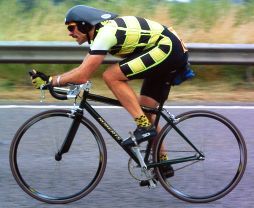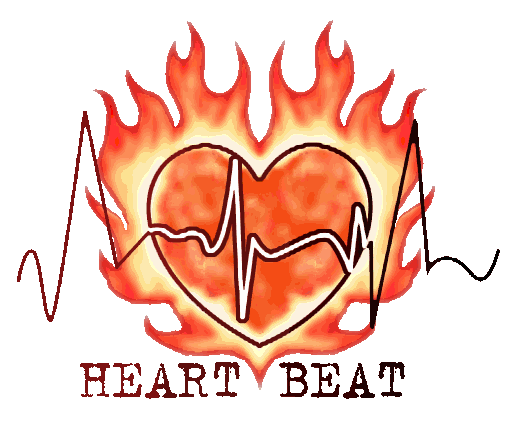Heart Rate Zones
So what did Father Christmas bring you? Lots of nice toys I hope. Perhaps a heart rate monitor, which is a great toy for the boys (and girls). It can add extra interest to your bike rides and if used as intended it can help to improve your fitness. They can now be purchased for as little as about £20 at Tesco, and even at that price it has several functions, including calorie counting.
 You will probably prefer to buy a big brand name and might consider a bike specific one such as this Polar CS100N Cycling Speed and Heart Rate Monitor, which is on offer for around £85. In addition to heart rate and calorie counting, it incorporates a bike computer showing speed, distance, etc, etc. Full details of it’s many features can be seen at, for example http://www.bhipltd.co.uk/heartratemonitor/polar-cs100n.html
You will probably prefer to buy a big brand name and might consider a bike specific one such as this Polar CS100N Cycling Speed and Heart Rate Monitor, which is on offer for around £85. In addition to heart rate and calorie counting, it incorporates a bike computer showing speed, distance, etc, etc. Full details of it’s many features can be seen at, for example http://www.bhipltd.co.uk/heartratemonitor/polar-cs100n.html
In a previous posting (http://anerleybc.org/what-is-your-maximum-heart-rate/) I pointed out that there is no consensus on the most accurate formula for estimating maximum heart rate (MHR). Similarly, there is no consensus on how best to determine the various training zones by reference to percentages of MHR. However your body does not switch from one zone to another at a specific number of beats as indicated by charts, etc. In reality it is a progressive transition from one zone to another, not a sudden switch over at for example 70% of MHR, from the so called “Fat Burning” Zone to the “Aerobic” Zone as shown below.
More recently, authorities on bike training such as the coaches of British Cycling and the Sky racing teams, now use different heart rate percentages to determine their training zones. They consider that these percentages more closely relate to when and where physiological changes are actually occurring during exercise.

These revised zones are:
Zone 1, 60 / 65% Easy Ride/Recovery
Zone 2, 65 / 75% Fat Burning
Zone 3, 75 / 82% Lower Aerobic
Zone 4, 82 / 89% Upper Aerobic (Threshold)
Zone 5, 89 / 94% Anaerobic
Zone 6, 94%+ Maximal.
For sports cyclists rather than dedicated racers, the point at which one zone might finish and another might begin is a bit academic. However we can get an appreciation of what these zones feel like by some simple testing.
For example go out and find a fairly level bit of road and cycle for a few minutes, first at circa 60% of MHR (very slow!), then circa 70%, (conversational speed) and then at circa 80% (brisk). You will be able to feel how the intensity increases, and perhaps more importantly how your breathing deepens with rising H/R. If you continue to increase the pace and/or go up an incline, at somewhere between 85 and 90% of your MHR you will cross your “threshold”, where you transition from aerobic to anaerobic. This is where very deep breathing changes to short sharp gasps for breath! The latter indicating that you are going into oxygen debt, and thus anaerobic.
 So having experienced the relationship between increasing effort/oxygen uptake and increasing H/R, we can consider some of the effects and some of the benefits of these zones. Let us start with British Cycling’s Zones 1 and 2 which cover the H/R range from 60 to 75% of max.
So having experienced the relationship between increasing effort/oxygen uptake and increasing H/R, we can consider some of the effects and some of the benefits of these zones. Let us start with British Cycling’s Zones 1 and 2 which cover the H/R range from 60 to 75% of max.
You may wonder how Tour de France riders manage to ride for hour after hour, day after day. One reason is that they have spent many hours of training at very low intensity. This teaches their bodies to become very efficient at using fat as an energy source. And we all have plenty of that!
Racing cyclists will typically do 1,500 or more miles of low intensity base training, to build their endurance before getting into serious race training. A typical endurance ride for Lance Armstrong was quoted as being 4 to 6 hours at an average heart rate of between 62 and 64% of MHR.
According to the Heart Rate Monitor Book, at these low intensities the energy sources utilised would be circa: 80% fat, 15% carbohydrate and 5% protein.
However we do not have the luxury, or probably the inclination, to go out cycling the country side for long hours nearly every day. We are better off upping the pace a bit. This is a quote from The Long Distance Cyclists Handbook:
” High volume rides at the slightly higher intensity of Zone 2 (65 /75% MHR) provide a greater overload of the cardiovascular system – fundamental to building a good foundation of aerobic endurance. Riding at this intensity develops the highest rate of fat burning. Provided that proper attention is given to avoiding carbohydrate and fluid loss, rides at this intensity can continue for many hours, and are typical of training rides and most randonnees/audax rides“.
I might add that much of our Sunday club rides would fall into Zone 2, from easy conversational pace at lower levels of Zone 2, to brisk riding and climbing our more gentle hills at upper Zone 2.
Zone 3, 75 to 82% of max H/R is more intense, requiring some concentration to keep the pace up. Breathing becomes heavier and conversation is reduced to short sentences. The effort to climb Surrey’s hills will take you into Zone 3, or even Zone 4 for the steeper ones!
Zone 3 is claimed to be the most effective for general cycle training. It builds endurance, strength and speed, but due to increased use of glycogen at this level of effort, training sessions will be time limited.
Up until the recent past the mantra for cyclists was “Get the miles in”. However recent research and testing has shown that whilst getting the miles in is important to build endurance, training benefits can be gained much quicker by training more intensely for shorter periods. This has given rise to H.I.T – High Intensity Training – and takes us into Zone 4.
 Zone 4, 82 to 89% of max H/R is commonly referred to as “threshold ” or “lactate threshold” training. When you go anaerobic your muscles are not getting sufficient oxygen. This causes the “burn” as they become flooded with lactic acid and you have to slow down to relieve the pain. The idea behind lactate threshold training is to keep just below the point at which lactic acid begins to build up. Then you can maintain a high level of training for longer. Time trialling is the art of racing at just below the threshold for the race distance. But as most of us are not time trialists our threshold rides are more likely to occur on occasions such as climbing up Box Hill!
Zone 4, 82 to 89% of max H/R is commonly referred to as “threshold ” or “lactate threshold” training. When you go anaerobic your muscles are not getting sufficient oxygen. This causes the “burn” as they become flooded with lactic acid and you have to slow down to relieve the pain. The idea behind lactate threshold training is to keep just below the point at which lactic acid begins to build up. Then you can maintain a high level of training for longer. Time trialling is the art of racing at just below the threshold for the race distance. But as most of us are not time trialists our threshold rides are more likely to occur on occasions such as climbing up Box Hill!
The the Heart Rate Monitor Book, says that when riding at around the “threshold” there is a complete reversal of the energy sources utilised. At this intensity carbohydrate becomes the primary fuel at circa 70%, whilst fat drops to 25%. Protein remains at a constant 5%.

Zone 5, 89% to 94% for most cyclists will be anaerobic (some top racing cyclists do not transition until around 95% but probably not us!)
You will all have heard of the saying “No pain no gain!” Well not quite true. Sports scientists have come up with H.I.I.T, High Intensity Interval Training. It has long been known that going anaerobic has big fitness benefits. The problem has been that a). It hurts, and b). After a very short time you have to stop and rest whilst the lactic acid disipates. Interval training was a solution to these problems.
Short bursts of high intensity exercise are stopped before lactic acid has time to accumulate in any quantity. A short rest period, or interval, between exercise bouts allows the lactic acid to be neutralised. This results in a greater tolerance to lactic acid and gradually extends the time at which high powered anaerobic cycling can be maintained. Perhaps of equal importance is that H.I.I.T raises the lactate threshold, and with it both power and endurance levels. A win, win, outcome!
More on how to benefit from training in the near future.



Des,
Very interesting article, graph, and points on Target HR Zones. Was that provided by the Polar company? Would you happen to have or be able to point me to the primary medical references establishing the various heart rate zones and their relative safety?
Thanks
Hi Dan,
You could start with a look at http://www.drmirkin.com/fitness/9156.html This item by Dr Mirkin is one of the sources that I have referred to earlier. Dr Mirkin provides info of medical journals and other sources which may help. However access to these professional journals are normally by subscription only, but abstracts are often available. The abstracts are very technical and not easy to understand!
For an example abstract, which relates to experimental research into high intensity interval training, see http://link.springer.com/article/10.1007%2Fs00421-011-2254-z
In recent years there has been a lot of research into interval training and its undoubted benefits.
There was a very interesting documentary on BBC television last year, about high intensity interval training. It is worth looking at if you are interested in cycle (or other) fitness training. This item at http://www.bbc.co.uk/news/health-17177251 will explain what the programme was all about. It provides links to various research items, plus a link to a video of the BBC television programme.